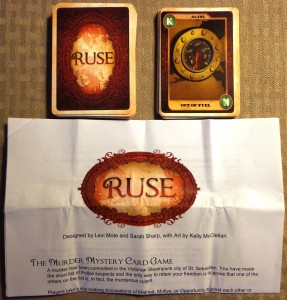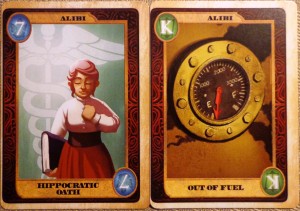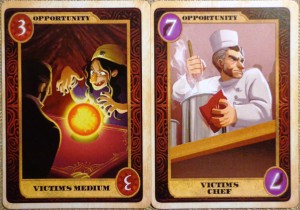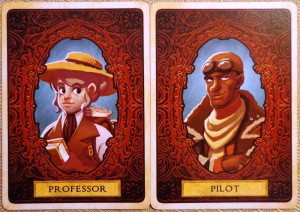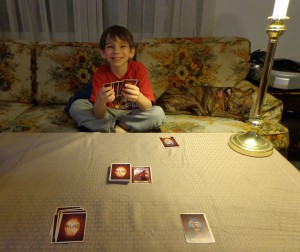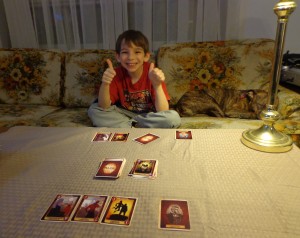Ruse is labeled as a murder mystery card game, but there’s a little bit more to it than that. It’s like taking a “whodunit”, simplifying it with a deck of cards, and adding a storytelling element with a Victorian Steampunk setting. A little bit of Clue, a touch of Gloom, a dash of Once Upon A Time…you get the idea. In Ruse, players will be attempting to pin the murder on someone else by using the cards in their hands. Once a player is found to be the murderer, the game is over and the losing player tells his or her sad story.
Before we take a look at the game in detail, I’d like to thank David MacKenzie from Game Salute for sending me a free preview copy. It’s important to note that like all prototype copies, rules and components are subject to change…though I’m told that the artwork on the cards themselves is final.
Components
Deck of fifty-two playing cards – Like in a normal deck of cards, there are four suits, though there are differences. The “gear” and “pistol” suits are offensive in nature (methods, motives, and opportunities) and are played to eliminate other players while the “crystal” and “lamp” suits are defensive in nature (alibis) and are played to cancel / discard cards of the former suits.
Character cards – Each player will receive one, which may be used later in the game when covering up evidence. More on that in a bit.
Setup & Gameplay
First, each player chooses a character card and places it color-side up. Each player is dealt five cards (which they keep to themselves) and the deck is placed in the middle of the table within easy reach of everyone. A single card is drawn from the deck to start a face-up discard pile next to it. The person to the dealer’s left starts the game.
On a player’s turn, they will draw a card from the deck or discard pile and then do one of the following actions:
1. Make an Accusation – The player will take a method, motive, or opportunity card (gear and pistol suits) from their hand and play it face up in front of another player. It’s important to keep in mind however that players cannot have more than one type of accusation card in front of them at a time…that is…a player can have method and a motive card in front of them but not two method cards. It’s also important to note that the cards in front of a player must be of the same suit. Accusation cards played against another player remain there until removed by an alibi card or through the “cover up evidence” action.
2. Provide an Alibi – The player will play an alibi card (crystal and lamp suits) from their hand that matches the value of one of the cards in front of them. For example, a player might play an ace of crystals against the ace of pistols in front of them. Both cards are discarded face up, the order in which they are discarded is determined by the player.
3. Cover up Evidence – The player can flip over their character card to the colorless / gloomy side one time and one time only to discard an accusation card in front of them. This card is placed on the bottom of the discard pile. The player also must discard a card from their hand, which is placed on top of the discard pile.
4. Discard – If a player cannot do ANY of the three previously mentioned actions, they can discard a card from their hand.
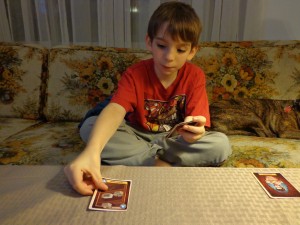
Here, Vinnie is able to discard one of my accusation cards by playing an alibi card of the same value.
During the game, players are free to tell stories when performing these actions or when they lose. The goal is to get one of each accusation card in front of another player…remember, they must all be of the same suit! If a player’s turn ends and they cannot get rid of one of the three cards in front of them (should they have a set of three in front of them), they lose and the game ends.
The above is simply an overview and doesn’t cover all of the rules, but should still give you an idea of how the game is played. You can check out the manual for more information, located here:
The Review
First, I’d like to commend the game for being flexible enough in that you can use it as a regular deck of playing cards. This allows players to break up a game or two of Ruse with Poker, Blackjack, or whatever game they know of that can be played with a standard deck of cards.
While there isn’t a lot of deduction or logic in terms of figuring out the murderer, there’s a bit of strategy involved in what cards to play when. For example, if you have a card that would cause another player to have a set of three accusation cards in front of them, you might choose to hold onto it until another player forces them to cover up evidence. By that same token, you could wait until you had two or more cards to play against someone else and bombard them on subsequent turns…kind of like a one-two punch.
I won’t know what the final product will look like so I can’t comment on the quality of the components, though as I mentioned earlier, I was told that the artwork is final. The art is indeed full of theme and has that Steampunk feel to it. The artwork, combined with all of the different accusation cards, allows creative minds to come up with some wild stories to tell during their game. Of course, the storytelling bit is optional but makes for a nice addition to the game for those who choose to utilize it.
Vinnie (11) and I tried playing a two player game, just to see if the play experience would be any different. I’m pleased to report that we still had fun and didn’t have to adjust the rules in any way. We found however that there was some different strategies that we could employ. Just as an example, I had seven of pistols in my hand that I wanted to get rid of, along with a seven of crystals and a seven of lamps. The seven of pistols could be used against me, which is what I was counting on. I picked up and discarded that seven of pistols, which Vinnie picked up and played against me, allowing me to pick up and use one of my other sevens to discard it. In effect, I had gotten rid of two cards I didn’t need. Moral of the story when playing a two player game: watching what you discard really becomes important.
Overall, Ruse is a light, fun card game that is best played in a casual atmosphere. The bonus of being able to use it as a regular card deck makes it a viable reason to bring it with you to game night at a friend’s house or whatever the case may be. Play time can vary depending on the luck of the cards, though our games never lasted longer than an hour, making it a good choice for school nights. Whether you’re a card connoisseur looking for that next variant or a parent looking for a new game to play with the kids, Ruse won’t disappoint.
You can support and learn more about “Ruse” by visiting its Kickstarter page, here:
You can find this game on BoardGameGeek here:

